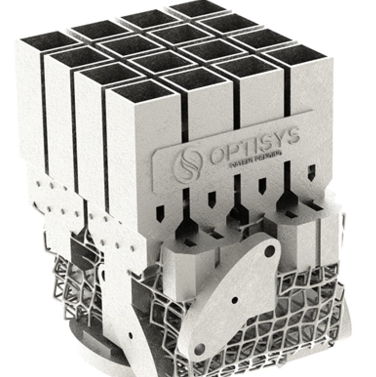 |
| June 19, 2018 | Volume 14 Issue 23 |
Designfax weekly eMagazine
Archives
Partners
Manufacturing Center
Product Spotlight
Modern Applications News
Metalworking Ideas For
Today's Job Shops
Tooling and Production
Strategies for large
metalworking plants
100 parts down to 1: Amazing antenna 3D-printing demo
Optisys, a provider of sophisticated, 3D-printed metal micro-antenna products for high-performance aerospace and defense applications, completed a project last year that documents the significant advantages of employing additive manufacturing (AM) to produce such systems.
Wow!

Antennas are critical for conveying information (voice, video, and/or data) across long distances. They are widely employed in commercial and military aircraft, spacecraft, satellite communications, unmanned aerial vehicles (UAVs), and by ground terminals and land-based troops. Yet the complex radio frequency (RF) components that make up an antenna system can be large and heavy -- characteristics that can impact mobility and performance.
"Companies in the commercial and military space are pressured for shorter lead times, lighter weight, and smaller antennas," says Clinton Cathey, Optisys CEO. "By combining RF design simulation, mechanical engineering, and system optimization focused on AM, we provide metal 3D-printed antenna products at greatly reduced size, weight, lead times, part count, and cost -- with as good or better RF performance than conventionally manufactured systems. We're creating structures that were simply not possible to produce in the past."
The test-piece demonstrator project involved a complete redesign of a high-bandwidth, directional tracking antenna array for aircraft (known as a Ka-band 4x4 Monopulse Array). Optisys performed every aspect of the design work in-house and printed the component in a single piece on their Concept Laser metal-printing machine.
"Concept Laser's powder-bed fusion, in particular, is perfect for this application because of the fine resolution it provides for antennas functioning in the 1- to 100-Gigahertz [GHz] range of RF in which most of our potential customers operate," says Cathey.
Manufacturing antenna systems via conventional methods such as brazing and plunge EDM is a complex, multistage process that can take an average of eight months of development time and three to six more of build time, says Robert Smith, Optisys COO.
"Our unique offering is that we redesign everything from an additive manufacturing perspective," says Smith. "We take into account the entire system functionality, combine many parts into one, and reduce both development and manufacturing lead times to just a few weeks. The result is radically improved size and weight at lower costs."
Optisys conducted a profitability analysis on how their redesigned microwave antennae test piece compared to a legacy design that is traditionally manufactured. By optimizing their design for additive manufacturing, Optisys realized the following benefits:
- Part count reduction from 100 discrete pieces to a one-piece integrated assembly;
- Weight savings of over 95 percent;
- Lead time reduced from 11 months to 2 months;
- Production costs reduced by 20 to 25 percent; and
- Non-recurring costs reduced by 75 percent.
Other advantages of 3D printing
"In addition to what our test-piece project revealed, 3D printing offers a number of other advantages," says Smith. "When we design multiple antenna components into a single part, we reduce the overall insertion loss of the combined parts. And because our antennas are so much smaller, this also lowers insertion loss dramatically despite the higher surface roughness of AM build, for similar or even better RF performance than conventional assemblies."
Optisys can print in a variety of metals with its Concept Laser machine, though for antenna products they prefer aluminum because of its surface conductivity, light weight, corrosion resistance, and strength under shock and vibration.
"3D-printed metal will have virtually the same properties as a solid piece of the same material for RF performance," says Smith. "Structurally, the products have been tested in rigorous vibration environments, and they also have the same coefficient of thermal expansion (CTE) as wrought metals. This also gives them better stability over temperature than plastic RF components."
Part consolidation through AM provides a number of downstream benefits as well, Smith says. "Reducing part count also reduces assembly and rework. It's easy to add features to an existing AM design, easier to assemble the finished components, and, long term, you have less testing, maintenance, and service when you have fewer parts."
The Optisys team has a combined 60 years of aerospace experience in SATCOM (satellite communications), RF design, LOS (Line-of-Sight) communications, and mechanical design. "We've spent years on parameter and process development of our antenna-system optimization technology package," says Cathey. "We validate our designs through simulation, test to all aerospace frequencies, and manufacture military-ruggedized production parts."
The company has a number of patents pending and is in discussions with leading aerospace companies and academic institutions about expanding its portfolio of product lines.
Source: Optisys
Published June 2018
Rate this article
View our terms of use and privacy policy
